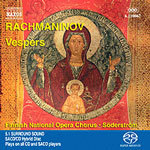
Rachmaninov: All-Night Vigil, Op. 37, Vespers
 $25.00
Out of Stock
$25.00
Out of Stock6+ weeks add to cart
SERGEI RACHMANINOV
Rachmaninov: All-Night Vigil, Op. 37, Vespers
Eugen Antoni (tenor) / Raisa Palmu (soprano) / Erja Wimeri (contralto) / Finnish National Opera Chorus. Eric-Olof Soderstrom, conductor
[ Naxos SACD / SACD ]
Release Date: Saturday 15 January 2005
This item is currently out of stock. It may take 6 or more weeks to obtain from when you place your order as this is a specialist product.
Rachmaninov had been in contact with Orthodox sacred music since his childhood. The influence of Orthodox chant is clearly detectable in his music, for instance in his use of stepwise motion, a characteristic of Orthodox chant, in his themes. - Hybrid SACD in 5.1 Surround Sound.
Hybrid SACD in 5.1 Surround Sound.
Playable on all CD players
Sergey Vasilyevich Rachmaninov was born into a wealthy estate-owner's family near Novgorod. His father squandered the family property, which had to be sold in 1880. The family moved to St Petersburg. Sergey showed musical talent from an early age. From the age of four, his mother taught him the piano. On the advice of his uncle, the pianist Alexander Ziloti, he moved to Moscow to study the piano and composition. At the Conservatory he completed his final examinations as a pianist in 1891 and as a composer in 1892, and before the turn of the century, his works had already found broad popularity. Disappointed with the cool reception given by audiences and critics to his First Symphony, he focused on a career as a pianist, performing actively in Russia and, from 1899 onwards, in Western Europe.
In the early years of the twentieth century, Rachmaninov entered a new creative period, which culminated in the Second and Third Piano Concertos, the opera Francesca da Rimini and the Second Symphony. He wrote few choral works. His most significant sacred works, the Liturgy of St John Chrysostom (1910) and the All-Night Vigil (1915) date from this second period. Later he wrote no more sacred music.
Rachmaninov had been in contact with Orthodox sacred music since his childhood. The influence of Orthodox chant is clearly detectable in his music, for instance in his use of stepwise motion, a characteristic of Orthodox chant, in his themes. On the other hand, his works also reflect to a great extent the Impressionism and Symbolism of the turn of the twentieth century. His music fascinates the listener with its richness of melodic invention, its Slavic intensity and its incisive rhythms. The All-Night Vigil
The Russian term vsjenoshchnoe bdeniye refers to a vigil that lasts through the night. This is a historical practice that survives to this day, a divine service in several parts, which if said in its entirety, as it still is in monasteries, takes all night.
The corresponding terms agrypnia (Greek) and vigilia (Latin) also refer to staying awake or standing guard or, metaphorically, being vigilant. In ecclesiastical use, the term usually refers to a prayer service held at night; there are indications from the second century onward that the term was particularly associated with Easter. Great feasts were preceded by a vigil lasting all night, not only at Easter (the 'mother of all vigils') but at Christmas and Epiphany too. Staying up all night was also associated with feasts of martyrs and with wakes held for the deceased.